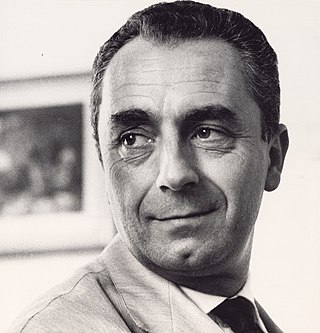
Michelangelo Antonioni was an Italian director and filmmaker. He is best known for his "trilogy on modernity and its discontents"—L'Avventura (1960), La Notte (1961), and L'Eclisse (1962)—as well as the English-language film Blowup (1966). His films have been described as "enigmatic and intricate mood pieces" that feature elusive plots, striking visual composition, and a preoccupation with modern landscapes. His work substantially influenced subsequent art cinema. Antonioni received numerous awards and nominations throughout his career, being the only director to have won the Palme d'Or, the Golden Lion, the Golden Bear and the Golden Leopard.
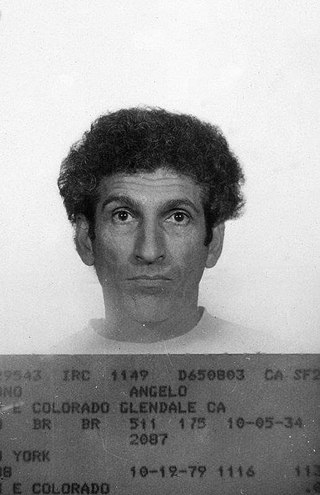
Angelo Anthony Buono Jr. was an American serial killer, kidnapper and rapist who, together with his adopted cousin Kenneth Bianchi, were known as the Hillside Stranglers. Buono and Bianchi were convicted of killing ten young women in Los Angeles, California, between October 1977 and February 1978.

Albert Henry DeSalvo was an American rapist/killer and suspected serial killer in Boston who purportedly confessed to being the "Boston Strangler," the murderer of thirteen women in the Boston area from 1962 to 1964. In 1967, DeSalvo was imprisoned for life for committing a series of rapes; however, his murder confession has been disputed and debate continues as to which crimes he actually committed.
The Boston Strangler is the name given to the murderer of 13 women in Greater Boston during the early 1960s. The crimes were attributed to Albert DeSalvo based on his confession, on details revealed in court during a separate case, and DNA evidence linking him to the final victim.

Henry Lee Lucas, also known as The Confession Killer, was an American convicted murderer. Lucas was convicted of murdering his mother in 1960 and two others in 1983. He rose to infamy as a claimed serial killer while incarcerated for these crimes when he falsely confessed to approximately six hundred other murders to Texas Rangers and other law enforcement officials. Many unsolved cases were closed based on the confessions and the murders officially attributed to Lucas. Lucas was convicted of murdering eleven people and condemned to death for a single case with a then-unidentified victim, later identified as Debra Jackson.

La Piovra is an Italian television drama series about the Mafia. The series was directed by various directors who each worked on different seasons, including Damiano Damiani, Florestano Vancini, Luigi Perelli, and Giacomo Battiato . The music was written by Riz Ortolani, Ennio Morricone, and by Paolo Buonvino.

So Dark the Night is a 1946 American crime film with film noir influences, featuring Steven Geray, Micheline Cheirel, and Eugene Borden. Based on a story written by Aubrey Wisberg, the screenplay was written by Dwight V. Babcock and Martin Berkeley, and directed by Joseph H. Lewis.
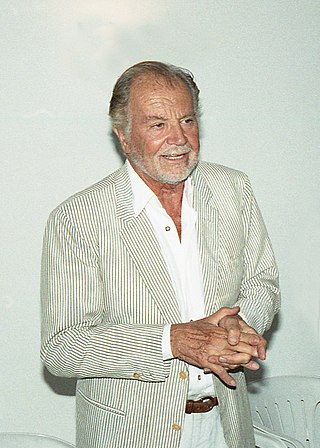
Gabriele Ferzetti was an Italian actor with more than 160 credits across film, television, and stage. His career was at its peak in the 1950s and 1960s.

Love in the City is a 1953 Italian anthology film composed of six segments, each with its own director. The segments and filmmakers are: Paid Love, Attempted Suicide, Paradise for Three Hours, Marriage Agency, Story of Caterina, and Italians Stare.

I Vampiri is a 1957 Italian horror film directed by Riccardo Freda and completed by the film's cinematographer, Mario Bava. It stars Gianna Maria Canale, Carlo D'Angelo and Dario Michaelis. The film is about a series of murders on young women who are found with their blood drained. The newspapers report on a killer known as the Vampire, which prompts young journalist Pierre Lantin to research the crimes. Lantin investigates the mysterious Du Grand family who lives in a castle occupied by Gisele Du Grand who is in love with Lantin. She lives with her aunt, who hides her face in a veil, as well as the scientist Julian Du Grand, who is trying to find the secret to eternal youth.
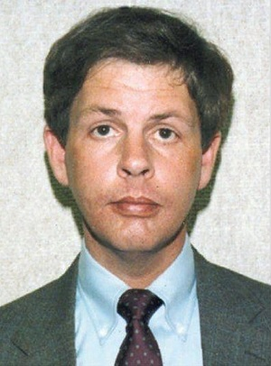
Herbert Richard Baumeister was an American businessman and suspected serial killer. A resident of the Indianapolis suburb of Westfield, Indiana, Baumeister was under investigation for murdering over a dozen men in the early 1990s, most of whom were last seen at gay bars. Police found the remains of eleven men, eight identified, on Baumeister's property. Baumeister committed suicide after a warrant was issued for his arrest. He was later linked to a series of murders of at least eleven men along Interstate 70, which occurred in the early 1980s to the early 1990s.

Murders in the Rue Morgue is a 1932 American horror film directed by Robert Florey, based on Edgar Allan Poe's 1841 short story "The Murders in the Rue Morgue". The plot is about Doctor Mirakle, a carnival sideshow entertainer and scientist who kidnaps Parisian women to mix their blood with that of his gorilla, Erik. As his experiments fail because of the quality of his victims' blood, Mirakle meets with Camille L'Espanye, and has her kidnapped and her mother murdered, leading to suspicion falling on Camille's fiance, Pierre Dupin, a medical student who has already become interested in the earlier murders.

The Haunted Strangler is a 1958 British horror film directed by Robert Day. It was adapted from "Stranglehold", a story which screenwriter Jan Read had written specially for Boris Karloff, and was shot back to back with producer Richard Gordon's Fiend Without a Face, with both later being released as a double feature by MGM.
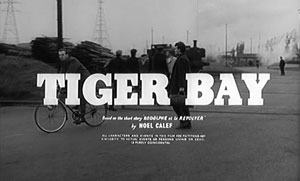
Tiger Bay is a 1959 British crime drama film based on the short story "Rodolphe et le Revolver" by Noël Calef. It was directed by J. Lee Thompson, produced by John Hawkesworth, and co-written by John Hawkesworth and Shelley Smith. It stars John Mills as a police superintendent investigating a murder; his real-life daughter Hayley Mills, in her first major film role, as a girl who witnesses the murder; and Horst Buchholz as a young sailor who commits the murder in a moment of passion.

Franco Interlenghi was an Italian actor.
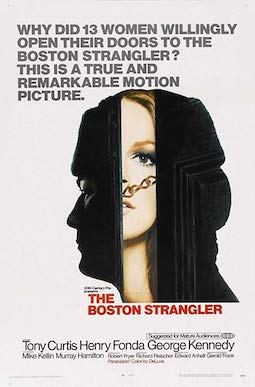
The Boston Strangler is a 1968 American biographical crime drama film directed by Richard Fleischer and starring Tony Curtis, Henry Fonda, George Kennedy, Mike Kellin, Murray Hamilton, Sally Kellerman and William Hickey. It is loosely based on the true story of the Boston Strangler and the 1966 book of the same name by Gerold Frank.

Beyond the Clouds is a 1995 Italian-French-German romance film directed by Michelangelo Antonioni, with contributions by Wim Wenders, and starring John Malkovich, Sophie Marceau, Vincent Perez, Irène Jacob, and Jean Reno. The film consists of four stories of romantic love and illusion told from the perspective of a wandering film director. In the first story, two beautiful young lovers are unable to consummate their passion because the young man desires impossible perfection. In the second story, the director makes love to a young woman who reveals that she murdered her father. In the third story, a man makes an effort to appease both his wife and his mistress. In the fourth story, a young man is infatuated with a girl who is about to enter a convent. This was the final feature-length film by Antonioni before his death in 2007.
Lee Roy Martin, known as The Gaffney Strangler, was an American serial killer from Gaffney, South Carolina. He murdered 4 people, 2 women and 2 girls between 1967 and 1968.

Nothing Underneath is a 1985 Italian thriller film directed by Carlo Vanzina. The film is about Bob Crane who has visions of his fashion model twin sister being murdered in Milan, but finds his sister has disappeared on his arrival in Italy.
Pasha is a 1968 French crime film directed by Georges Lautner that stars Jean Gabin and Dany Carrel and is based on the novel Pouce! by Jean Laborde. It tells the story of a senior Paris policeman pursuing a ruthless killer.
















